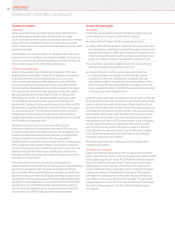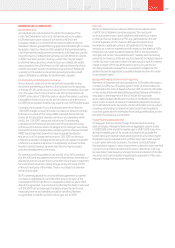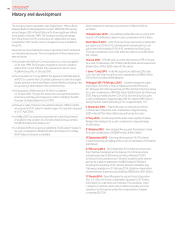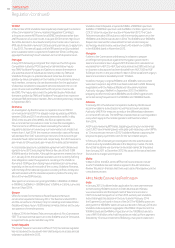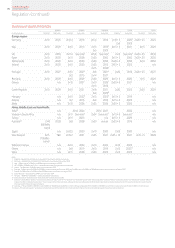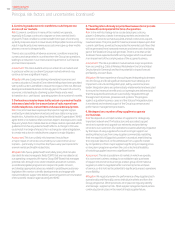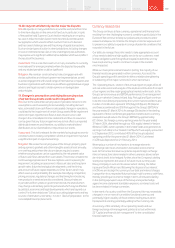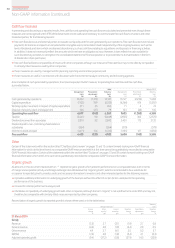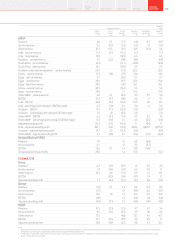Vodafone 2014 Annual Report Download - page 199
Download and view the complete annual report
Please find page 199 of the 2014 Vodafone annual report below. You can navigate through the pages in the report by either clicking on the pages listed below, or by using the keyword search tool below to find specific information within the annual report.
2. We could suffer loss of consumer condence and/or legal
action due to a failure to protect our customer information.
Risk: Our networks carry and store large volumes of condential
personal and business voice trafc and data. We host increasing
quantities and types of customer data in both enterprise and consumer
segments. We need to ensure our service environments are sufciently
secure to protect us from loss or corruption of customer information.
Failure to adequately protect customer information could have
a material adverse effect on our reputation and may lead to legal action
against the Group.
Assessment: This risk is possible in all markets in which we operate.
The impacts of this risk have the potential to be major in mature
markets, with robust data protection regulations and a higher
proportion of customers paying their bills by automated bank transfer
or credit card, than in some of the emerging markets who have a more
cash based pre-pay customer population.
Mitigation: Both the hardware and software applications which hold
or transmit condential personal and business voice and data trafc
include security features. Security related reviews are conducted
according to our policies and security standards. Security governance
and compliance is managed and monitored through software tools
that are deployed to all local markets and selected partner markets.
Our data centres are managed to international information security
standards. Third party data security reviews are conducted jointly with
our technology security and corporate security functions.
3. Increased competition may reduce our market share
and protability.
Risk: We face intensifying competition; in particular competing with
established competitors in mature markets and competing with new
entrants in emerging markets, where all operators are looking to secure
a share of the potential customer base. Competition could lead
to a reduction in the rate at which we add new customers, a decrease
in the size of our market share and a decline in our average revenue per
customer, if customers choose to receive telecommunications services
or other competing services from alternate providers. Competition can
also lead to an increase in customer acquisitions and retention costs.
The focus of competition in many of our markets has shifted from
acquiring new customers to retaining existing customers, as the market
for mobile telecommunications has become increasingly mature.
Assessment: This is a major risk that is relevant to all markets. The source
of the risk varies depending upon the maturity of each market
as mentioned above.
Mitigation: We will continue to promote our differentiated propositions
by focusing on our points of strength such as network quality,
capacity and coverage, quality of customer service and the value
of our products and services. We are enhancing distribution channels
to get closer to customers and using targeted promotions where
appropriate to attract and retain specic customers. We closely
monitor and model competitor behaviour, network builds and product
offerings to understand future intentions so that we are able to react
in a timely manner.
4. Regulatory decisions and changes in the regulatory
environment could adversely affect our business.
Risk: We have ventures in both emerging and mature markets, spanning
a broad geographical area including Europe, Africa, Middle East, and Asia
Pacic. We need to comply with an extensive range of requirements
that regulate and supervise the licensing, construction and operation
of our telecommunications networks and services. Pressure on political
and regulatory institutions both to deliver direct consumer benet
and protect consumers’ interests, particularly in recessionary periods,
can lead to adverse impacts on our business. Financial pressures
on smaller competitors can drive them to call for regulators to protect
them. Increased nancial pressures on governments may lead them
to target foreign investors for further taxes or licence fees.
Assessment: This risk is highly likely in emerging markets, where
there is experience of regulation being used as a revenue gathering
mechanism that has the potential for a signicant impact in that market.
Mitigation: We monitor political developments in our existing and
potential markets closely, identifying risks in our current and proposed
commercial propositions. Regular reports are made to our Executive
Committee on current political and regulatory risks. These risks are
considered in our business planning process, including the importance
of competitive commercial pricing and appropriate product strategies.
Authoritative and timely intervention is made at both national and
international level in respect of legislative, scal and regulatory
proposals which we feel are not in the interests of the Group. We have
regular dialogue with trade groups that represent network operators
and other industry bodies to understand underlying political pressures.
5. Our existing service offerings could become
disadvantaged as compared to those offered by converged
competitors or other technology providers (“over the top” –
OTT competitors).
Risk: In a number of markets, we face competition from providers who
have the ability to sell converged services (combinations of xed line,
broadband, public Wi-Fi, TV and mobile) on their existing infrastructure
which we cannot either replicate or cannot provide at a similar price
point. Additionally, the combination of services may allow competitors
to subsidise the mobile component of their offering. This could lead
to an erosion of our customer base and reduce the demand for our core
mobile services and impact our future protability.
Advances in smartphone technology places more focus on applications,
operating systems, and devices, rather than the underlying services
provided by mobile operators. The development of applications
which make use of the internet as a substitute for some of our more
traditional services, such as messaging and voice, could erode
revenue. Reduced demand for our core services of voice, messaging
and data and the development of services by application developers,
operating system providers, and handset suppliers (commonly referred
to as “over the top” or OTT competition) could signicantly impact our
future protability.
Assessment: This risk is likely in mature markets where more
competitors have the assets to offer converged offers and where, in high
density population areas, alternative data services are commonly
available and has the potential for a major impact on service revenues.
Mitigation: In some markets we are already providing xed line
telecommunication services (voice and broadband). In other existing
markets we actively look for opportunities to provide services beyond
mobile through acquisition, partnerships, or joint ventures.
We have also developed strategies which strengthen our relationships
with customers by accelerating the introduction of integrated voice,
messaging and data price plans to avoid customers reducing their out
of bundle usage through internet/Wi-Fi based substitution.
197Overview Strategy
review Performance Governance Financials Additional
information



